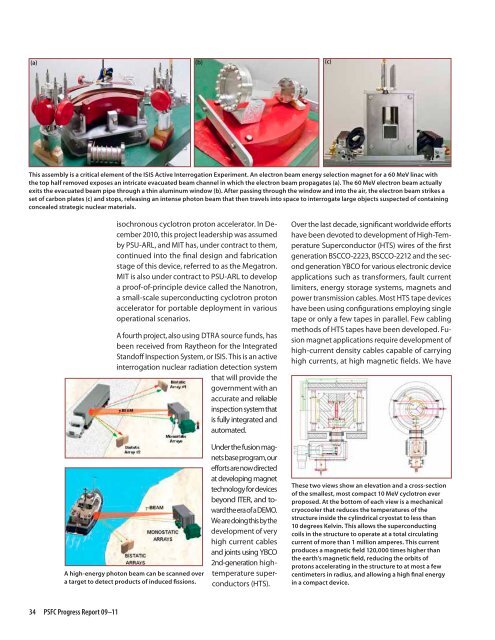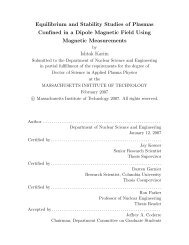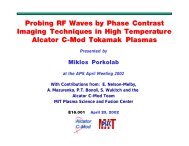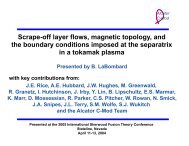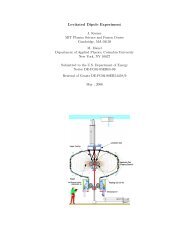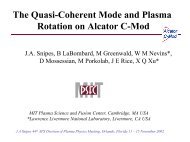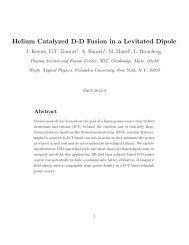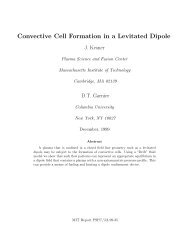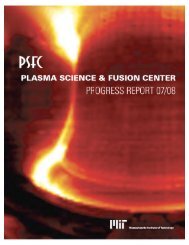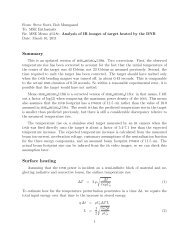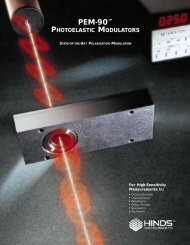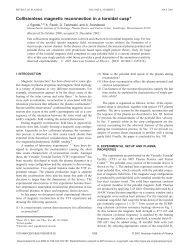Download a copy of the latest PSFC Progress Report - Plasma ...
Download a copy of the latest PSFC Progress Report - Plasma ...
Download a copy of the latest PSFC Progress Report - Plasma ...
You also want an ePaper? Increase the reach of your titles
YUMPU automatically turns print PDFs into web optimized ePapers that Google loves.
(a) (b) (c)<br />
This assembly is a critical element <strong>of</strong> <strong>the</strong> ISIS Active Interrogation Experiment. An electron beam energy selection magnet for a 60 MeV linac with<br />
<strong>the</strong> top half removed exposes an intricate evacuated beam channel in which <strong>the</strong> electron beam propagates (a). The 60 MeV electron beam actually<br />
exits <strong>the</strong> evacuated beam pipe through a thin aluminum window (b). After passing through <strong>the</strong> window and into <strong>the</strong> air, <strong>the</strong> electron beam strikes a<br />
set <strong>of</strong> carbon plates (c) and stops, releasing an intense photon beam that <strong>the</strong>n travels into space to interrogate large objects suspected <strong>of</strong> containing<br />
concealed strategic nuclear materials.<br />
isochronous cyclotron proton accelerator. In December<br />
2010, this project leadership was assumed<br />
by PSU-ARL, and MIT has, under contract to <strong>the</strong>m,<br />
continued into <strong>the</strong> final design and fabrication<br />
stage <strong>of</strong> this device, referred to as <strong>the</strong> Megatron.<br />
MIT is also under contract to PSU-ARL to develop<br />
a pro<strong>of</strong>-<strong>of</strong>-principle device called <strong>the</strong> Nanotron,<br />
a small-scale superconducting cyclotron proton<br />
accelerator for portable deployment in various<br />
operational scenarios.<br />
A fourth project, also using DTRA source funds, has<br />
been received from Ray<strong>the</strong>on for <strong>the</strong> Integrated<br />
Stand<strong>of</strong>f Inspection System, or ISIS. This is an active<br />
interrogation nuclear radiation detection system<br />
that will provide <strong>the</strong><br />
government with an<br />
accurate and reliable<br />
inspection system that<br />
is fully integrated and<br />
automated.<br />
Over <strong>the</strong> last decade, significant worldwide efforts<br />
have been devoted to development <strong>of</strong> High-Temperature<br />
Superconductor (HTS) wires <strong>of</strong> <strong>the</strong> first<br />
generation BSCCO-2223, BSCCO-2212 and <strong>the</strong> second<br />
generation YBCO for various electronic device<br />
applications such as transformers, fault current<br />
limiters, energy storage systems, magnets and<br />
power transmission cables. Most HTS tape devices<br />
have been using configurations employing single<br />
tape or only a few tapes in parallel. Few cabling<br />
methods <strong>of</strong> HTS tapes have been developed. Fusion<br />
magnet applications require development <strong>of</strong><br />
high-current density cables capable <strong>of</strong> carrying<br />
high currents, at high magnetic fields. We have<br />
A high-energy photon beam can be scanned over<br />
a target to detect products <strong>of</strong> induced fissions.<br />
Under <strong>the</strong> fusion magnets<br />
base program, our<br />
efforts are now directed<br />
at developing magnet<br />
technology for devices<br />
beyond ITER, and toward<br />
<strong>the</strong> era <strong>of</strong> a DEMO.<br />
We are doing this by <strong>the</strong><br />
development <strong>of</strong> very<br />
high current cables<br />
and joints using YBCO<br />
2nd-generation hightemperature<br />
superconductors<br />
(HTS).<br />
These two views show an elevation and a cross-section<br />
<strong>of</strong> <strong>the</strong> smallest, most compact 10 MeV cyclotron ever<br />
proposed. At <strong>the</strong> bottom <strong>of</strong> each view is a mechanical<br />
cryocooler that reduces <strong>the</strong> temperatures <strong>of</strong> <strong>the</strong><br />
structure inside <strong>the</strong> cylindrical cryostat to less than<br />
10 degrees Kelvin. This allows <strong>the</strong> superconducting<br />
coils in <strong>the</strong> structure to operate at a total circulating<br />
current <strong>of</strong> more than 1 million amperes. This current<br />
produces a magnetic field 120,000 times higher than<br />
<strong>the</strong> earth’s magnetic field, reducing <strong>the</strong> orbits <strong>of</strong><br />
protons accelerating in <strong>the</strong> structure to at most a few<br />
centimeters in radius, and allowing a high final energy<br />
in a compact device.<br />
34 <strong>PSFC</strong> <strong>Progress</strong> <strong>Report</strong> 09–11


